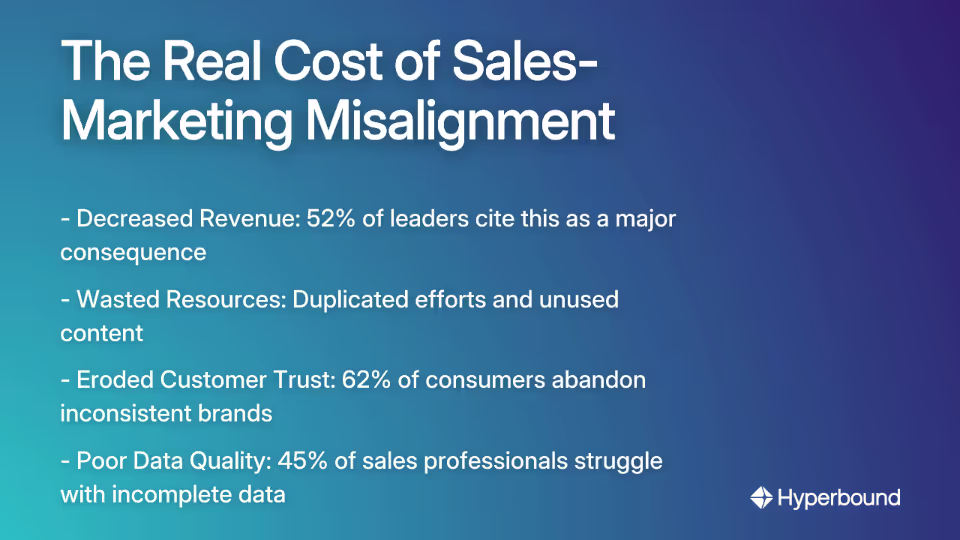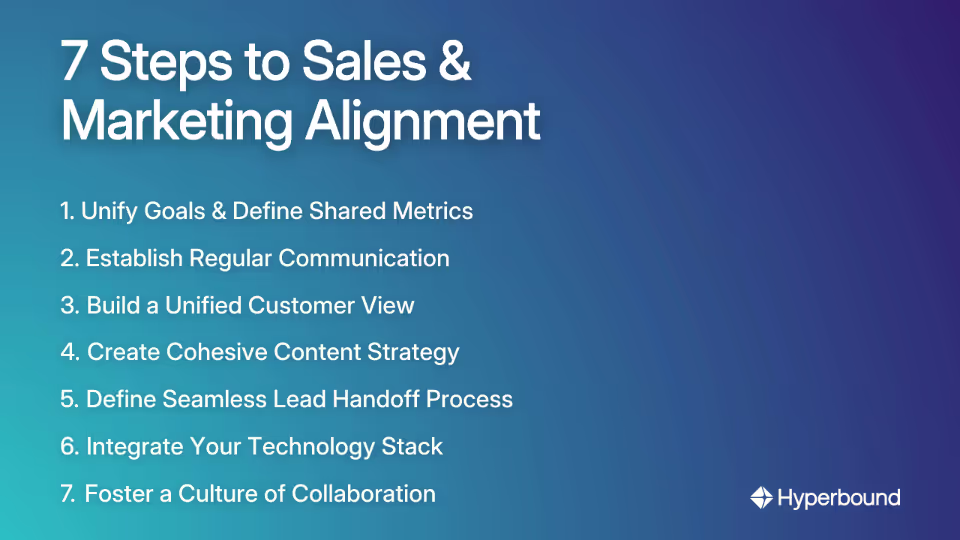
You've just wrapped up another frustrating quarter-end meeting. Marketing proudly presents their record-breaking lead numbers while sales management complains about lead quality. As the tension builds, you hear familiar criticisms: "Marketing doesn't help to sell" and "These leads are worthless." Meanwhile, the marketing team mutters about salespeople "wasting perfectly good leads."
If this scenario sounds painfully familiar, you're experiencing one of the most common and costly divides in business today: the sales and marketing misalignment.
The High Cost of Misalignment: More Than Just Office Friction
This isn't just about departmental squabbles. The financial impact is staggering. Consider that a Fortune 250 B2B company wasted $250,000 trying to fix the wrong problem simply because its sales and marketing teams weren't aligned. According to Harvard Business Review, this is far from unusual.
The consequences of this misalignment extend beyond wasted budgets:

- Decreased Revenue: A 2023 HubSpot report found that 52% of leaders cite low revenue as a major consequence of misalignment.
- Wasted Resources & Effort: Marketing creates collateral that sales never uses. Sales develops their own messaging that contradicts marketing campaigns. Both teams duplicate efforts that could be streamlined.
- Erosion of Customer Trust: When prospects receive inconsistent messaging throughout their buyer journey, confusion and mistrust follow. With 62% of consumers refusing to stay loyal to brands that don't provide tailored experiences, this inconsistency is costly.
- Poor Data Quality: The LinkedIn State of Sales Report reveals that 45% of sales professionals cite incomplete data as a top challenge – a direct result of information silos between departments.
At its core, the problem stems from differing perspectives: Marketing focuses on driving awareness and generating demand, while Sales concentrates on capturing that demand and closing deals. Without alignment, these complementary functions become competing priorities.
The Payoff: Why "Smarketing" is a Superpower for Growth
"Smarketing" – the strategic integration of sales and marketing teams – isn't just a trendy buzzword. It's a proven approach that delivers measurable results:
- Companies with strong sales and marketing alignment achieve 19% faster revenue growth and 15% higher profitability, according to Forrester.
- Aligned organizations are 67% more effective at closing deals, as reported by Adobe.
- Superoffice reported a remarkable 34% revenue increase after integrating its teams, demonstrating the real-world impact of alignment.
When marketing and sales teams unite, they create a seamless customer experience, enhance efficiency, and gain competitive advantages through shared intelligence. Most importantly, they stop working at cross-purposes and start functioning as a unified revenue engine.
The Ultimate Playbook: 7 Steps to Unify Your Sales and Marketing Teams

Let's move beyond theory to practical implementation. Here's your step-by-step guide to creating alignment that drives results:
Step 1: Unify Goals & Define Shared Metrics (KPIs)
The fundamental problem is that marketing typically measures success by Marketing Qualified Leads (MQLs) generated, while sales focuses on closed deals and revenue. This creates an inherent conflict.
Solution: Establish shared revenue goals as the ultimate source of truth. According to insights from Reddit discussions, alignment improves when "marketers were more invested in the number of Sales Accepted Leads (SALs) and won business their campaigns generated, rather than just stuffing the funnel with MQLs."
Both teams should jointly track:
- Lead-to-Customer Conversion Rate
- Sales Cycle Length
- Customer Acquisition Cost (CAC)
- Overall Revenue Growth
Step 2: Establish Open and Regular Communication
"There has to be understanding between departments," notes one sales professional in a Reddit thread. This understanding doesn't happen by accident—it requires intentional communication structures.
Solution: Implement a structured communication plan:
- Schedule weekly or bi-weekly "Smarketing" syncs to discuss metrics, campaigns, and challenges
- Conduct joint quarterly planning sessions
- Use centralized communication tools like Slack or Microsoft Teams
- Create a culture where teams can "embrace difficult conversations" to address friction constructively
Step 3: Build a Unified Customer View (ICP & Personas)
A common complaint is that "marketing has a lack of understanding of customers," while marketers may feel that sales doesn't appreciate the broader market context.
Solution: Collaborate to define the Ideal Customer Profile (ICP) and buyer personas:
- Marketing brings market research, data analysis, and competitive insights
- Sales contributes direct customer feedback, common objections, and the "why" behind purchase decisions
- Together, create realistic, data-backed personas that both teams can use
This collaboration demands both Active Listening and Empathy—skills highlighted as essential in sales and marketing discussions.

Step 4: Create a Cohesive Content & Messaging Strategy
"Most people at Ad agencies have never actually SOLD a fucking thing in their lives," vents one frustrated sales professional. This perception leads to marketing content that sales finds irrelevant or ineffective.
Solution: Involve both teams in content creation:
- Sales should provide marketing with a list of frequently asked questions and pain points from prospects
- Marketing uses these insights to create highly relevant content (blog posts, case studies, battle cards, email templates)
- Regular feedback loops ensure content evolves based on field performance
Step 5: Define a Seamless Lead Handoff Process
Disputes over lead quality create significant friction. As one marketer observed, "Marketers believe salespeople are wasting their leads when they fail to convert, and salespeople want better leads from marketers."
Solution: Establish a clear, mutually agreed-upon process for transferring leads:
- Agree on Lead Qualification Criteria: Define precisely what constitutes a "qualified lead" using a framework like BANT (Budget, Authority, Need, Timeline).
- Establish a Service Level Agreement (SLA): This document should outline the roles and responsibilities of each team, including how quickly sales will follow up on marketing-generated leads.
- Implement a Feedback Loop: Sales must provide clear, documented reasons for rejecting leads, helping marketing refine targeting and campaigns.
Step 6: Integrate Your Technology Stack
Siloed data prevents a unified view of the customer journey and contributes to misalignment.
Solution: Create a shared technology ecosystem:
- Unified CRM: Implement a central CRM like Salesforce or HubSpot so both teams have a 360-degree view of every customer interaction.
- Marketing Automation: Integrate tools like Marketo or Pardot with the CRM to track lead behavior from the first touchpoint.
- Sales Readiness and Coaching Platforms: Ensure your teams can deliver the right message consistently. Platforms like Hyperbound use AI to analyze winning sales calls and create realistic roleplays, allowing reps to practice and master new messaging. AI-powered call scoring provides analytics on how effectively the new talk tracks are being used in real conversations, closing the loop between content strategy and field execution.
Step 7: Foster a Culture of Collaboration with Sales Enablement
Alignment isn't a one-time project—it's an ongoing cultural commitment.
Solution: Invest in a comprehensive Sales Enablement strategy:
- Define Sales Enablement as providing the sales team with the content, tools, training, and analytics they need to engage buyers effectively.
- Ensure leadership models aligned behaviors and incentivizes collaboration.
- Conduct cross-training where marketers listen to sales calls and salespeople participate in marketing strategy sessions.
- Celebrate successes together, recognizing both the marketing campaign that generated the lead and the sales team that closed it.
Measuring What Matters: How to Know if Your Alignment is Working

To determine if your alignment efforts are succeeding, monitor these key metrics:
- Lead Conversion Rate: An increasing rate from MQL to SAL to Customer indicates better lead quality and follow-up.
- Sales Cycle Length: A shorter cycle suggests better-qualified leads and more effective sales resources.
- Customer Acquisition Cost (CAC) & Revenue Growth: Lower CAC coupled with higher revenue proves the efficiency of your aligned model.
- Content Utilization: Track which marketing assets are most frequently used by sales and associated with won deals.
- Messaging Adherence: Use conversation intelligence to score how consistently reps are adopting the agreed-upon messaging from marketing campaigns in their calls.
From Divided Departments to a Unified Revenue Engine
Aligning sales and marketing isn't just about solving internal friction—it's about building a formidable engine for sustainable growth. As Gartner research confirms, this alignment has become a top priority for forward-thinking organizations.
The journey doesn't happen overnight. It requires commitment to shared goals, open communication, and mutual respect. But the payoff—faster growth, higher profitability, and a superior customer experience—makes it well worth the effort.
Start small: Schedule a joint meeting to define your ICP, agree on one shared KPI to track, or establish a regular communication cadence. Remember that "genuine connections are the currency of successful sales" and marketing. When these teams unite around the customer, extraordinary growth follows.
Your first step toward sales and marketing alignment begins now. The only question is: How much longer can your organization afford to have these critical functions working in silos rather than in sync?
Book a demo with Hyperbound
.png)













